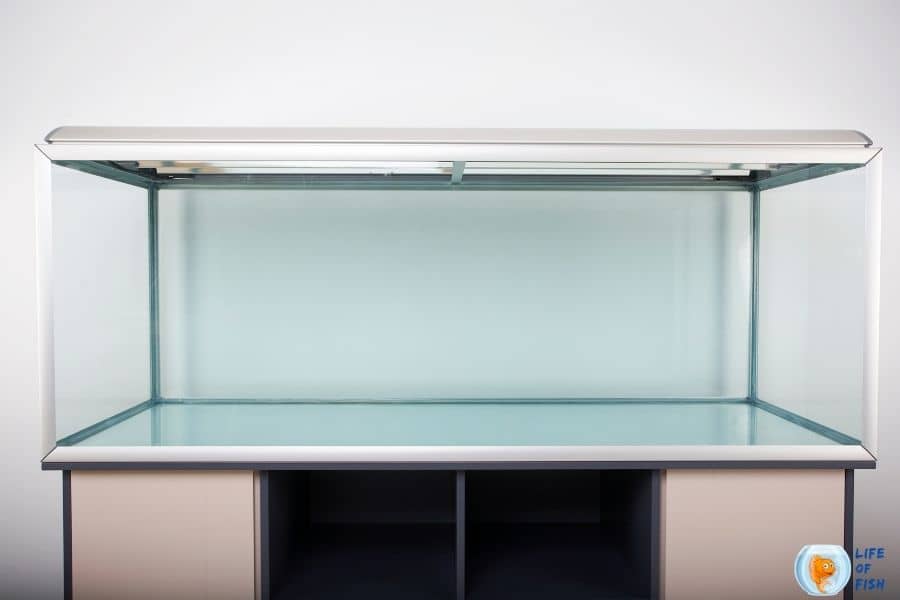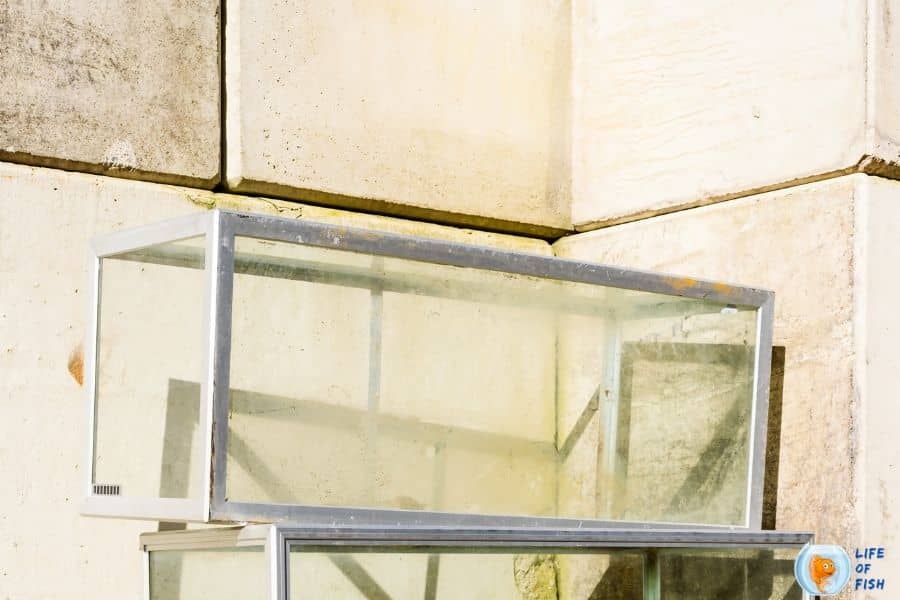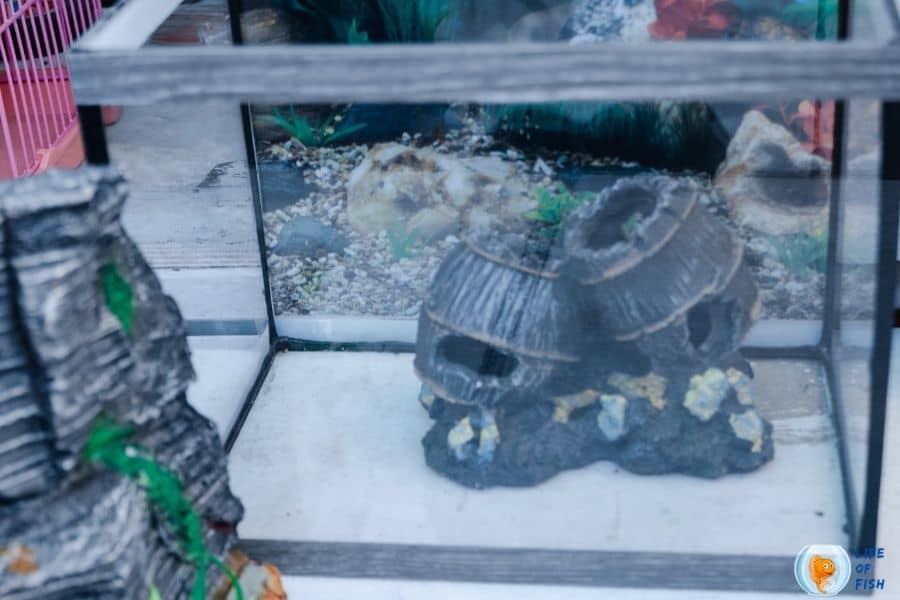I have a few empty tanks (good ones) in my backyard. one of my friends came to visit me and saw this fish tank sitting there. She asked me how long can an aquarium sits empty because she thought those tank can go bad. Is it true? Let me explain this to you.
Fish tanks can stay empty for a long time but that time depends on various reasons, such as; tank material, environmental conditions, etc. For example, an acrylic tank can stay empty longer than a glass tank. The reason is glass tanks can create cracks in the corner due to their silicon gluing. Also if you keep your tank outside without any cover or protection, it can not survive as an aquarium.
So like that there are a few things you should consider before keeping your aquarium empty. In this article, I am going to explain those to you in detail.

How long acrylic aquarium sits empty
Jump To
If your tank is made out of acrylic, it can go without water for as long as you want. Acrylic doesn’t have seams. So, there’s no way to leak water once filled up. Further, they can bear temperature changes as well.
How long glass aquarium sits empty
If you have a glass tank, things change a bit. If you keep your tank without water for a short period, that wouldn’t be a problem at all. But, if you want to keep your tank without water for months or years, it’s better to leak-proof the tank before adding any fish. Usually, tanks will be fine without water for a long time as long as the surrounding has a controlled temperature.
Glass fish tanks are made out of Glass and silicons. Silicon is prone to break when the temperature fluctuates. Glass is an inert element, so, Glass will not react with temperature changes and stay still without any harm. If you keep your aquarium empty for a long time, the silicon coating in the tank edges may break. However, you can fix this quickly by resealing the tank before refilling it with water.
Something interesting about old glass tanks
Although it is most unlikely, you may have a fish tank that dates to the 1950s. The fish tanks made in those days were made out of glass and metal frameworks. To seal the Glass into frameworks, they have used a black tar-like caulk. This caulk can not sit dried for more than a few weeks.
If it gets dried out for more than a few weeks, it leaks. So, if you have an antique fish tank, you have to fix it by removing that tar-like caulk and resealing it with silicon sealers. But, I guess many aquarists will not like to keep such fish tanks when they have access to modern-looking aquariums.

Can you keep fish in an empty tank?
Suppose you mean that a water-filled tank without decorations, filters, and other equipment, then yes. You can keep fish in an empty tank temporarily. Some fish species can even stay for a long time without any filters, heaters, etc.
One such fish species is betta fish. However, we don’t recommend keeping any aquarium life in an empty tank for an extended period of time because the fish may suffocate because of insufficient oxygen levels, poor water conditions, and stress because of not having a preferred habitat. If you mean an empty tank without any water, you know the answer. Fish can not survive without any water.
What will happen if I keep the aquarium sits empty?
If you keep a glass fish tank empty for a prolonged period, the water sealant starts to break because of temperature changes. The water sealant we use in aquariums is silicon. When in large temperature fluctuations like sudden temperature changes below freezing level, silicon can react by expanding or compressing. This expansion or compressing causes the adheres to break, which leaves holes in the tank here and there.
A fish tank Must hold water without a single leakage. Multiple holes in the fish tank make the tank unusable. However, there is a fix for this issue. Before using the empty aquarium again, be sure to reseal the tank by reattaching the Glass with a new aquarium-safe silicone sealant. But, be sure to fill your fish tank with water and check for about two weeks before introducing any aquatic life to your aquarium.
Can I leave my aquarium for two weeks?
Leaving an aquarium for up to 2 weeks is ok most of the time. Many aquatic animals are evolved to survive without any food for some time. Small fish species like mollies, bettas, and tetras can survive up to two weeks without any food, given that the water condition in the aquarium is ideal. However, if you are unsure of the fish’s safety while you are away, you can take safety measures before leaving.
Install an automatic fish feeder to your aquarium
An automatic fish feeder feeds the fish with given food automatically every day. So, you can be sure that your fish are well-fed while you are away. An automatic fish feeder leaves your hassle of daily feeding out.
Check filters, oxygen pumps, and heaters carefully
About one to two days before leaving, check if the equipment of your aquarium functions correctly. If you see any faults, either repair them or replace them with a new system to be safe.
Perform an 80% water change
The day before leaving, it’s better to do an 80% water change with an aquarium siphon. Remove any debris and other fish waste with the siphon while cleaning. In addition, clean the plants and other decorations as well. By following the above steps, you can make sure that the surrounding of your aquarium is safe for your aquatic life forms until you come home. If you intend to leave the aquarium for more than two weeks, it is better to leave a pet sitter at your home.

How long should the aquarium sits empty before adding fish?
You should leave a water-filled aquarium for at least two weeks before introducing any fish. While leaving the tank at this time, you should leave the filters turned on and add some beneficial bacteria to the tank. This process is called cycling. You should cycle the aquarium for about two weeks to ensure that the environment in the aquarium is safe for fish. You can buy beneficial bacteria online or at your local pet store. Before cycling the aquarium, you should treat the water for chlorine and ammonia.
A water conditioner or a dechlorinator can do this job. After cycling the tank for about two weeks, it is better to introduce some hardy fish such as minnows and danios first. If they are doing fine in your tank for about three to four days, you can slowly introduce other fish as well.
Read Next: Remineralize RO Water For Shrimp | 3 Easy Ways To Do It
